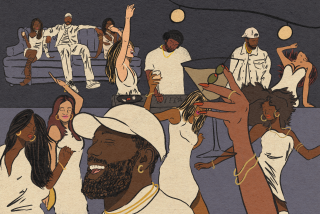Hazing G.I. Jane
“Cindy, Cindy, Cindy Lou/Love my rifle more than you/You used to be my beauty queen/Now I love my M-16.” With marching chants like this, how’s a woman supposed to feel comfortable in the U.S. Armed Forces? The latest book from UC Irvine associate professor Carol Burke, “Camp All-American, Hanoi Jane, and the High-and-Tight: Gender, Folklore and Changing Military Culture” (Beacon Press, 2004), examines rhymes, chants and hazing rituals for clues to gender attitudes in the military. Burke, a folklore specialist, served on the faculty of the U.S. Naval Academy in Annapolis from 1984 to 1991 and also spent a week at “Camp All-American,” the ROTC cadet training program at Ft. Bragg, N.C. She argues that when it comes to gender parity in the military, “the devil is in the details”--misogynist, sadistic and homoerotic rituals and customs that turn boys into fighting men but create a culture of exclusion at odds with the official statements on gender equality issued by the Pentagon’s top brass.
--Mark Ehrman
Why did you focus on ritual as a clue to gender relations in the military?
The first semester when I was at the Naval Academy, I started becoming aware of all these marching chants. One morning as I was walking to my building this group of would-be Marines--the Marines recruit officers from the Naval Academy as well--were running by. I heard, “Rape! Maim! Kill Babies! HUAH! Rape! Maim! Kill Babies! HUAH!” Later, one of my classes said, ‘Don’t worry, ma’am, when we first heard those kinds of things, we thought they were really awful too, but after you say them for a couple of weeks, you don’t hear the words anymore.”
You document military folklore equating weakness with femininity. How did that notion come to be?
If you look at the anthropological work, male initiation stages the rebirth of boys from childhood into the status of manhood. It’s often ritually enacted through military initiation and things like a fraternity’s pledge. You take the individual out of the gender-integrated society so the young boy is born again at the hands of only males. The individual is often infantilized. There are often homoerotic aspects. This period of homosexuality, the belief goes, gives the male his potency.
Some of the Abu Ghraib prison abuse images involved female personnel.
It comes right out of military rituals. The shocking image that we saw most frequently was Lynndie England with the leash and this Iraqi prisoner in a dog collar, leading him around on all fours, a picture of woman as dominatrix. I don’t think there’s any evidence that these rituals are being orchestrated by women. I think England was posing, and she’s very low on the chain of command. There was a superior there. I could show you a tape I have of a Special Forces initiation in which the one black guy was also led around on all fours with a leash. That is what these soldiers fell back on when given the command to soften these prisoners up.
You note that the worst military hazing happens out of public view. Yet the Abu Ghraib abuses were amply photographed and videotaped. Is that surprising?
This ritual humiliation and debasement is almost always photographed, not just in the military but also in fraternity rites too. It’s secret, but it’s documented within the group. In the Air Force, some officers--pilots or navigators and other back-seaters who fly fighter aircraft--have formed this little informal group called the Barstoolers. It’s a kind of drinking group, They’re guys in their 30s and 40s, and they still moon each other. I sometimes get a guy’s hairy bottom in my e-mail. The photograph is preserved to provide the continuing sense of humor.
Yet the Abu Ghraib whistleblowers were males showing the empathy and conscience that military culture calls “female” according to your book.
The students I had at the Naval Academy were some of the brightest people of integrity I’ve ever taught. I think the military does attract many people who have a great deal of integrity and personal strength, but the culture is very powerful.
You argue that military culture blocks gender equality. Yet racial integration of U.S. Armed Forces is considered a success story. Why the contrast?
Groups of positions or jobs or billets have been set aside as male. Women still aren’t allowed into combat. You have institutionalized difference and discrimination. And you have this body of cultural material that has less to do with efficiency and readiness and more with inscriptions of manhood.
Military organizations seek on some level to harness and refine aggression, a trait often considered predominantly male. Isn’t there value to that approach?
Defining aggression as testosterone out of control is a liability, particularly as the military becomes much more technologically controlled. Other militaries have integrated women into submarines, but the Navy is planning submarines that will come off the line eight years from now. None of them include berths for women. You find our military increasingly in positions where it’s called upon to keep the peace. In many ways women are raised to solve disputes by diplomacy.
More to Read
Sign up for our Book Club newsletter
Get the latest news, events and more from the Los Angeles Times Book Club, and help us get L.A. reading and talking.
You may occasionally receive promotional content from the Los Angeles Times.







